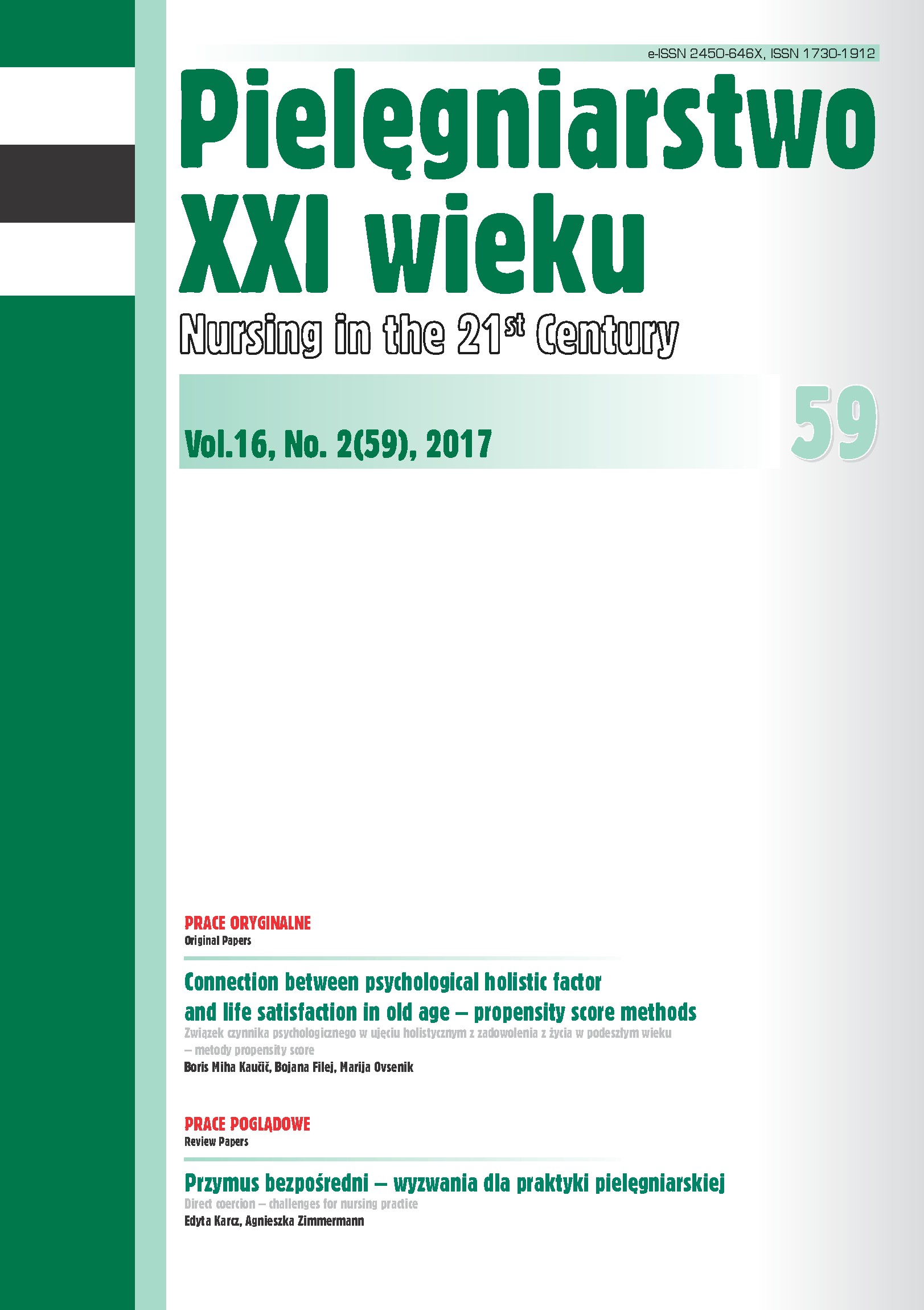Health literacy and health related lifestyle among nursing students
DOI:
https://doi.org/10.1515/pielxxiw-2017-0017Keywords:
health care, behavior related to health, health literacyAbstract
HEALTH LITERACY AND HEALTH RELATED LIFESTYLE AMONG NURSING STUDENTS
Introduction. Nursing students are an important population for the study of health literacy and health-related behaviours. On one hand, they are a population of young adults, that is starting to independently take care of their own health and on the other hand, they are becoming professionals who will provide support and pass knowledge to people making changes in their lifestyle in order to preserve their health or to manage a disease. The focus of this research is therefore oriented towards the study of health literacy and behavior related to health in the population of nursing students.
Material and methods. We have studied health literacy and behaviour related to health on a sample of 337 students from the health care study programmes in Slovenia. We utilised two instruments to measure students’ health literacy (Health Literacy Screening Questions and Quick assessment of literacy and primary care – Newest vital sign) and a scale to measure health-related behaviors.
Results. Factor analysis identified three dimensions of health literacy: the understanding of health or disease, the understanding of the instructions received in the health system and the orientation within the health system. Variables related to health literacy and health-related behaviors are closely connected.
Discussion and conclusion. The education of nursing students should put emphasis on the topics of health literacy and their own health care. It should also support and encourage students to maintain healthy living habits, as they themselves should set an example of what they teach the patients.
References
1. Marks R. Health Literacy and School-Based Health Education. New York: York College, The City University of New York and Teachers College, Columbia University; 2012.
2. Lee S-YD, Arozullah AM, Cho YI. Health literacy, social support, and health: a research agenda. Soc Sci Med. 2004; 58(7): 1309-1321.
3. Speros C. Health literacy: concept analysis. J Adv Nurs. 2005; 50(6): 633-640.
4. Baker DW. The meaning and the measure of health literacy. J Gen Intern Med. 2006; 21(8): 878-883.
5. Paasche-Orlow MK, Wolf MS. The causal pathways linking health literacy to health outcomes. Am J Health Behav. 2007; 31(1): S19-26.
6. Van Servellen G. Communication skills for the health care professional; concepts, practice and evidence, 2nd ed. Jones and Barlett, Sudbury (Ma.). 2009, p. 203.
7. Manganello JA. Health literacy and adolescents: a framework and agenda for future research. Health Education Research. 2008; 23(5): 840-847.
8. Ghaddar SF, Valerio MA, Garcia CM, Hansen L. Adolescent Health Literacy: The Importance of Credible Sources for Online Health Information. J Sch Health. 2012; 82(1): 28–36.
9. Zarcadoolas C, Pleasant A, Greer DS. Understanding health literacy: an expanded model. Health Promot Int. 2005; 20(2): 195-203.
10. Sorensen K, Van den Broucke S, Fullam J, et al. Health literacy and public health: a systematic review and integration of definitions and models. Am J Trop Med Publ Health. 2012; 12(80): 6-13.
11. Nutbeam D. Health promotion glossary. Health Promot Int. 1998; 13(4): 349-364.
12. Kanj M, Mitic W. Health Literacy and Health Promotion. Nairobi, Kenya: World Health Organization. 2009. Available at: http://www.who.int/healthpromotion/conferences /7gchp/Track 1_Inner.pdf.
13. Nutbeam D. Defining and measuring health literacy: what can we learn from literacy studies?. Int J Publ Health. 2009; 54 (5): 303-305.
14. Liechty J. Health literacy: critical opportunities for social work leadership in health care and research. Health Soc Work. 2011; 36(2): 99-107.
15. Kamin T. Zdravje na barikadah. Dileme promocije zdravja. Ljubljana: Univerza v Ljubljani. Fakulteta za družbene vede. 2006.
16. Long AF, Gambling T. Enhancing health literacy and behavioural change within a tele-care education and support intervention for people with type 2 diabetes. Blackwell Publishing Ltd Health Expectations. 2011;15(3): 267–282.
17. Deeks A, Lombard C, Michelmore J, Teede H. The effects of gender and age on health related behaviors. BMC Public Health. 2009; 9(213): 1-8. doi:10.1186/1471-2458-9-213.
18. Grappasonni I, Petrelli F, Klusoňova H, Kračmarova L. Level of understanding of medical terms among italian students. Ceska Slov Farm. 2016; 65(6): 216-220.
19. Shu-Ching Y, Yi-Fang L, Chia-Hsun C. The Associations Among Individual Factors, eHealth Literacy, and Health-Promoting Lifestyles Among College Students. J Med Internet Res. 2017;19(1): e15. DOI: 10.2196/jmir.5964.
20. Chew LD, Bradley KA, Boyko EJ. Brief questions to identify patients with inadequate health literacy. Family Medicine. 2007; 36(8): 588-594.
21. Štemberger Kolnik T, Babnik K. Development of the health literacy instrument for Slovenian population : results of the pilot study. V: Železnik D, (ur.), Kaučič BM, (ur.), Železnik U. (ur.). Innovation in step with the time - best practice examples: proceedings of lectures with peer rewiev. Slovenj Gradec: University College of Health Sciences; 2012, p. 248-255.
22. Sarafino EP. Health Psychology. Biopsychosocial Interactions. Fifth.ed. Hoboken (NJ): J. Wiley & Sons, cop; 2006, p. 140.
23. Weiss BD, Mays MZ, Martz W, et al. Quick assessment of literacy in primary care: the newest vital sign. Ann Fam Med. 2005; 3(6): 514-522.
24. Zarcadoolas C, Pleasant FA, Greers D. Advancing Health Literacy. A frame work for Understanding and Action. San Francisco: John Wiley&Sons; 2006, p. 1-6.
Published
Issue
Section
License
Copyright (c) 2017 Authors

This work is licensed under a Creative Commons Attribution-NonCommercial-NoDerivatives 3.0 Unported License.




